All 5 entries tagged Tesserae
No other Warwick Blogs use the tag Tesserae on entries | View entries tagged Tesserae at Technorati | There are no images tagged Tesserae on this blog
December 07, 2021
Engraving Roman 'tesserae': the 'Vota Publica' tokens from Girolamo Tanini's collection
Since the sixteenth century, a special and enigmatic late Roman token emission, the ‘Vota Publica’ series, has received attention from antiquarians, dealers and collectors. These tokens, produced in either bronze or brass by the Roman mint, depict the effigies of Roman emperors from Diocletian (AD 284-305) to Valentinian II (AD 375-392) on the obverse (called the ‘imperial’ series). Instead of an imperial image they might also carry the busts of Serapis, Isis, or Hermanubis (or the jugate busts of Serapis and Isis) (called the ‘anonymous’ series). A number of ritual scenes and images referring to different aspects of Egyptian and Isiac cults are shown on the reverses, which are mostly accompanied by the legend ‘Vota Publica’ (= ‘public vows’). Due to the distinctive Egyptian religious iconography of these artefacts, a number of drawings or engravings of the ‘Vota Publica’ tokens appeared in several books, catalogues, and other contributions from the sixteenth to the early twenty centuries. These drawings reproduce, sometimes with a good degree of accuracy, some of the types found in the existing material, although the precise identification of the depicted specimens remains debated in most cases.
Two drawings reproducing ‘Vota Publica’ specimens are known to this author as showing an otherwise unattested obverse-reverse type combination. These designs were included by Girolamo (Hieronymus) Tanini in the plates of his ‘Supplementum’ to Banduri’s volume ‘Numismata Imperatorum Romanorum a Trajano Decio ad Palaelogos Augustos’ (Lutetiae, 1718), which was published in Rome in 1791 (Fig. 1)(Numismatum Imperatorum Romanorum a Trajano Decio ad Constantinum Draconem ab Anselmo Bandurio editorum Supplementum, Romae 1791). In this volume, Tanini catalogued hundreds of gold, silver and bronze coins from the reign of Trajan (AD 98-117) up to until that of Constantine XI Palaiologos (1149-1453). Most of the specimens recorded by Tanini existed as part his own collection, but others came from other collections or were taken from different books and catalogues. Girolamo Tanini was a priest and erudite greatly interested in numismatics, who served in Florence for the Rinuccini family as educator of Marquis Folco Rinuccini’s children Giovanni and Alessandro, as well as curator of the library housed in Palazzo Rinuccini. In this role, Tanini was also in charge of the numismatic collection of the Rinuccini family, which was initiated by Folco’s father, Marquis Carlo Rinuccini (1679-1748).

Fig. 1. Frontispiece of the ‘Supplementum’ by G. Tanini (1791).
In his ‘Supplementum’, Tanini described around seventy ‘Vota Publica’ tokens from both the ‘imperial’ and ‘anonymous’ series, most of which were part of his own collection. However, he only illustrated six of these specimens. Two of them, belonging to the ‘anonymous’ issue, came from Cardinal Stefano Borgia’s collection (1731-1804), and were later acquired by the Vatican. The other four were part of Tanini’s collection.
Of these, two display the pearl-diademed bust of the emperor Jovian facing right on the obverse, accompanied by the legend D N IOVIANVS P F AVG COS, while on the reverse is the type of Isis seated facing on high-backed throne, suckling Horus-Harpocrates (Fig. 2), or the type of Serapis-Agathodaemon and Isis-Thermouthis facing one another, carrying a sacred vase between them from which a serpent emerges (Fig. 3). The tokens depicted in these two drawings, labelled as AE2 (‘secundae formae’), might be identified with two rare specimens bearing the same obverse and reverse type and legend and with the same diameter, which are currently housed in the Vatican collection. The other two drawings provided by Tanini depict the draped bust of Isis facing left on the obverse, wearing a basileion and holding a sistrum in her right hand, while on the reverse is the image of Isis standing right on a galley with oars sailing right. Although these images are widely attested in the available material, none of the surviving specimens show a combination of these two types.
 |
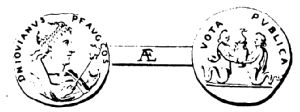 |
| Figure 2: Tanini 1791, p. 324, pl. VI. | Figure 3: Tanini 1791, p. 324, pl. VI. |
In the ‘Supplementum’, Tanini placed these two tokens under the coinage of Helena, the emperor Julian’s wife (died AD 360). As was common in his time, Tanini considered the busts of Serapis and Isis displayed on these tokens as disguised representations of Julian (AD 361-363) and Helena, following the idea that the production of some of these token issues was connected to Julian’s “pagan renaissance”. Tanini’s description of the two considered specimens is as follows:
1) TANINI 1791, p. 321, pl. VI:
Obverse: ‘VOTA PVBLICA (sic). Protome Isidis, vel Helenae, absque velo, cum flore loti, dextrorsum, d. sistrum, s. ad pectus gemmatum composita’.
Reverse: ‘VOTA PVBLICA. Isis sinistrorsum, stans in triremi, utraque manu velum regit’.
The first of the two specimens (Fig. 4) was labelled as AE3 (‘tertiae formae’) by Tanini. While the combination of the illustrated obverse and reverse types, with the legend VOTA PVBLICA occurring on both sides of the token, is not found in any of the known specimens today, it is worth paying attention to a similar specimen from the Vatican collection - Biblioteca Apostolica Vaticana (BAV) inv. no. Mt. Rom. Imp. Helena Iuliani 32. Although in a poor condition, this piece bears the same obverse type and legend as Tanini’s token, and the reverse also looks extremely similar with only one small difference: Isis has turned her head and is looking backwards (left), while on Tanini’s drawing Isis faces forward. It is tempting to assume that the specimen once owned by Tanini matches the Vatican piece, presuming that he misread the reverse type due to the poor condition of the token. However, no data on the acquisition of the piece by the Vatican collection is available. Moreover, the presence of a hole on the Vatican piece, which is not shown in Tanini’s drawing, may make this idea unlikely. If genuine, the piece described and figured in Tanini’s ‘Supplementum’ could provide evidence of an unrecorded ‘Vota Publica’ specimen.
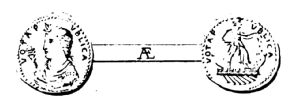 |
 |
| Figure 4: Tanini 1791, p. 321, pl. VI. | Figure 5: Tanini 1791, p. 322, pl. VI. |
2)TANINI 1791, p. 322, pl. VI:
Obverse: ‘DEA ISIS FARIA. Caput Isidis margaritis diadematum, collo duplici margaritarum monili ornato, humeris stolatis, d. sistrum’.
Reverse: ‘VOTA PVBLICA. Isis in triremi, sinistrorsum stans, velum tenet’.
The other specimen illustrated by Tanini (Fig. 5), labelled as A4 (‘quartae formae’), shows the same type combination of the previous piece, but it bears the obverse legend DEA ISIS FARIA instead of VOTA PVBLICA. As the available token specimens show, this legend was never used in the ‘Vota Publica’ series. Moreover, the obverse legend shown in Tanini’s drawing seems to incorporate two of the obverse legends found on the existing pieces with the bust of Isis, namely DE(ae) ISIDI (in the dative case) (Biblioteca Apostolica Vaticana (BAV) (inv. no. Mt. Rom. Imp. Helena Iuliani 30)) and ISIS FARIA (in the nominative case) (Fig. 6). If the piece drawn by Tanini was genuine, the legend DEA ISIS FARIA would be unique (an unicum). Actually, it is likely that the legend transcribed by Tanini was the result of a wrong interpretation. This is despite the fact that Tanini was aware that the legend ISIS FARIA, as well as the less common legend DE ISIDI, occurred on the obverse of the token specimens from the ‘anonymous’ series, as the specimens catalogued in his ‘Supplementum’ demonstrate.

Figure 6: AE, ‘Vota Publica’ token (19mm, 2.30g, 5h). Rome, IV century AD. Bertolami Fine Arts 24, 23.06.2016, lot 955, once part of the Archaeological Museum of Florence’s collection (MAF).
Sadly, the ‘Supplementum’ by Tanini is the only available source for the discussed specimens which, like much of the material published in his volume, are no longer traceable. Indeed, the Tanini collection is currently dispersed. This numismatic collection was incorporated at some point into the Ranuccini collection, which came in 1850 into the Medagliere Granducale of the Reale Galleria in Florence. In turn, the Medagliere Granducale was moved to the Archaeological Museum of Florence (MAF) since 1895. Regrettably, there is no trace of the ‘Vota Publica’ tokens described by Tanini either in the MAF collection or in their registers. As seen above, some of Tanini’s tokens may have been acquired by the Vatican collection at some point in the twentieth century, but the lack of data does not allow us to br certain on this point. Further archival research may hopefully shed light on the fate of the tokens that were once part of Girolamo Tanini’s collection.
This blog was written by Cristian Mondello as part of The creation of tokens in late antiquity. Religious ‘tolerance’ and ‘intolerance’ in the fourth and fifth centuries AD project, which has received funding from the European Union’s Horizon 2020 research and innovation programme under the Marie Skłodowska-Curie grant agreement No 840737.
Select Bibliography
- A. Alföldi, Isis-szertartások Rómában a negyedik század keresztény császárai alatt = A Festival of Isis in Rome under the Christian Emperors of the IVth Century, Budapest 1937.
- G. Capecchi et al., Palazzo Peruzzi. Palazzo Rinuccini, Rome 1980.
- H. Tanini, Numismatum Imperatorum Romanorum a Trajano Decio ad Constantinum Draconem ab Anselmo Bandurio editorum Supplementum, Romae 1791.
April 01, 2018
Tessera hospitalis: a gift for your guests
 |
|
Fig. 1: A drawing representing
the concept of hospitality.
(Tomasini 1670: 133).
|
“Hospitality” was worthy of high, valuable consideration in the Greek and Roman world. It is not a coincidence that Zeus Xenios was the powerful protector of guests. The Greek word for hospitality was xenia, while the Romans called it hospitalitas. This concept was strongly sincere and implied a true friendship between the host and the guest. The latter could be a friend or a relative, who came to his host’s house for a brief or long period of time (fig. 1). Moreover, hospitality was considered a sacred institution. It was therefore based on serious rules and rituals. First, the host had to accommodate the guest respectfully. Second, the guest had to esteem his host, being kind and gracious while he was staying at his house. Third, hospitality established a mutual exchange of favours, reciprocal esteem and a series of gifts. Among them, the host could donate a tessera hospitalis (token of hospitality) to his guest.
This ‘ad hoc’ gift was prepared and personalised every time to testify that the hospitality was successful and to strengthen the bond between the guest and the host. We even know that the tessera might be broken in two parts, one for the guest and one for the host. Considering how heart-felt and widespread the concept of hospitality was, it is quite surprising that these artefacts seem to be quite rare nowadays. Two such objects are currently preserved at the Archaeological Museum of Madrid (1st century BC) (Saquette 1997: 420, n. 238) and the Museum ‘B. Anselmi’ in Marsala (Trapani – Sicily), ancient Lilybaeum (Trapani – Sicily) (2nd-1st century BC) (Salinas 1873: 53).
A third tessera (fig. 2) found at Trasacco (Aquila) (fig. 3) in 1895, is now stored at the National Museum of Rome. Dated to the 2nd century BC, the artefact was published by Felice Barnabei (1842-1922), a well-known archaeologist and General Director of Antiquities and Fine Arts (1896-1900), who wrote a detailed paper in the Notizie degli Scavi di Antichità (Barnabei 1895: 85-93; Letta 2001: 152; Luschi 2008: 137-86). The tessera is curiously shaped as a ram’s head and carries the following Latin legend, testifying a mutual hospitality between T. Manlius and T. Staiodius:
T(itus)·Manlius·T(iti)·f(ilius)
hospes
T(itus)·Staiodius·N(umerii)·f(ilius)

Fig. 2: Tessera hospitalis found in Trasacco (Aquila) (Letta 2001: 152).

Fig. 3: Map showing Trasacco and Rome (Google Maps).
Antiquarians have been interested in tesserae hospitales since before the 19th century. For instance, Jacopus Philippus Tomasini (1595-1655) (fig. 4), Catholic bishop and learned historian born in Padua, even wrote even an entire book on these artefacts. Published in Amsterdam in 1670 and written in Latin, De tesseris hospitalitatis liber singularis (1670) (fig. 5) is a thorough 230-page essay that signifies Tomasini’s deep knowledge of Greek and Roman history and analyses the concept of hospitality through historical and antiquarian sources (fig. 6).
 |
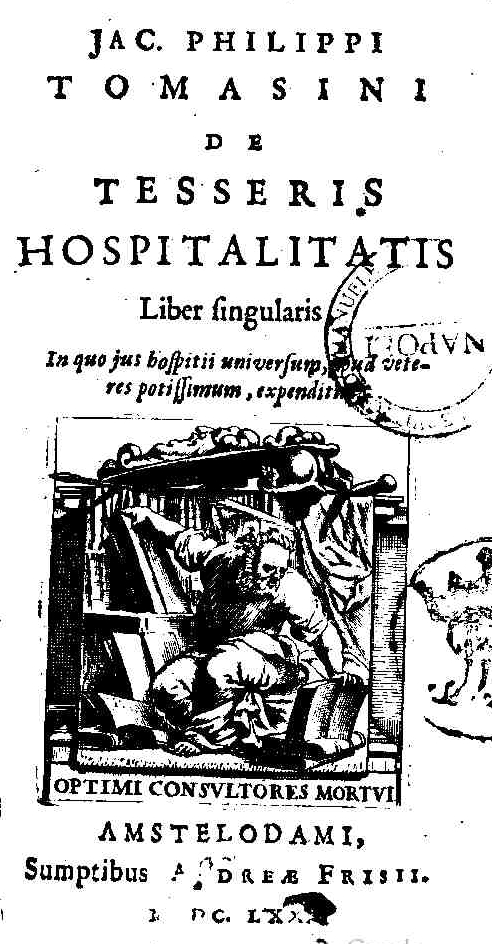 |
|
| Fig. 4: Portrait of Jacopus Philippus Tomasini (1595-1655) (Wikipedia). | Fig. 5: De tesseris hospitalitatis liber singularis by J. P. Tomasini (1670) (online, GoogleBooks). |

Fig. 6: Drawing of a tessera from a private collection (Tomasini 1670: 107)
Why did Tomasini write this work? He began to seriously think about his essay (serio mecum cogitare coepi) when he was in Rome admiring its ruins. Although the concept of hospitality was not ‘directly’ shown by Rome’s major antiquities, a targeted study was lacking and therefore it was essential to collect all the antiquarian and historical evidence (Tomasini 1670: 1-3).
 |
This blog post was written by Nino Crisa as part of the Token Communities in the Ancient Mediterranean Project. Nino is an archaeologist, numismatist and historian. His research and published works mainly focus on numismatics and the history of Sicilian archaeology and excavations, particularly on archival records, antiquarian collecting, the history of museum collections, antiquities safeguarding and legislation on the cultural heritage between the Bourbon and post-Unification periods (1816-1918).
Bibliography:
Barnabei, F. 1895, ‘Di una rarissima “tessera hospitalis” con iscrizione latina’, Notizie degli Scavi di Antichità: 85-93.
Letta, C. 2001, ‘Tessera hospitalis dal territorio di Trasacco’, in A. Campanelli (ed.), Il tesoro del lago. L’archeologia del Fucino e la Collezione Torlonia. Catalogo della mostra, Avezzano, 22 aprile-31 ottobre 2001. Pescara: Soprintendenza Archeologica dell’Abruzzo: 152.
Luschi, L. 2008, ‘L’ariete dei “Manlii”: note su una “tessera hospitalis” dal Fucino’, Studi Classici e Orientali, 54: 137-86.
Salinas, A. 1873, Del Real Museo di Palermo: relazione. Palermo (reported in V. Tusa (ed.) 1976, Scritti scelti, Palermo: Regione Siciliana, I: 240-86).
Saquette, J. C. 1997, ‘Tessera di ospitalità a forma di mano’, in J. Arce, S. Ensoli and E. La Rocca (eds.), Hispania Romana: da terra di conquista a provincia dell’impero. Catalogo della mostra, Roma, Palazzo delle Esposizioni, 22 settembre-23 novembre. Milan: Electa: 420.
Tomasini, J. P. 1670, De tesseris hospitalitatis liber singularis, in quo ius hospitii universum, apud veteres potissimum, expenditur. Amestlodami: Sumptibus Andreae Frisii.
January 01, 2018
The Animal Tokens of Rome
Token are coin-like objects, often made of lead, and interestingly, many examples have been found depicting animals of various species, from lions and elephants, to domestic animals such as horses. Often these items pertain to events organised for entertainment, such as chariot races, hunting, and finally the games themselves, and from studying other depictions of these same animals in Roman art, it becomes clear they may have had a use in these environments.
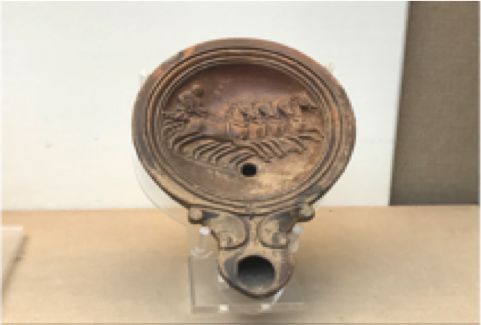 |
 |
|
An oil lamp showing an image of a
charioteer
|
A token from the Ashmolean museum
depicting a charioteer.
|
 |
|
A wax seal, from the British Museum,
depicting a horse and palm branch.
|
Chariot racing was perhaps the most popular sport in the Roman world, as can be seen when Lucian recounts that the “craze for horses is really great, you know, and men with a name for earnestness have caught it in great numbers” (Nigrinus, 29). In Rome, the event was held in the Circus Maximus, which could seat up to 150,000 people, and thus at any given time contain a sixth of the population. Horses feature commonly on tokens in many guises, such showing their domestic function of carrying heavy objects, but also, as seen above, in a more competitive atmosphere of the races. Since such imagery is seen elsewhere, such as an oil lamp, it clearly indicates tokens had a role within the stadia, possibly as entrance tickets for the races. Moreover, some tokens depict horses alongside palm branches. These branches are a symbol of victory, and the very same imagery can be seen on a wax seal from the 1-2nd century AD, also in relation to chariot racing. Thus it could also be suggested that tokens could commemorate a successful day at the races, or have a role in betting. Like today, the Romans would bet on horses, since chariot races involved four different teams, each with their own groups of supporters.
Furthermore, there is also a suggestion that tokens could have had a role in hunting. Hunting had been important in Roman society for centuries, starting as a way to catch food, but later developing into an elite hobby, intended to both train young men for military action, and improve their morality. Some aristocrats had game parks, and there are scenes of the hunt depicted in mosaics, to decorate the domestic space. This indicates how the sport was a popular pastime, and even a status symbol. Some images on tokens are very similar to this mosaic, showing a hunter closing in on a boar, holding his spear aloft. Perhaps therefore, tokens were invites to a hunt, or a commemorative item. This particular image however, could also have come from the games, as boars were hunted both privately, and as part of the entertainment provided in the amphitheatre.
 |
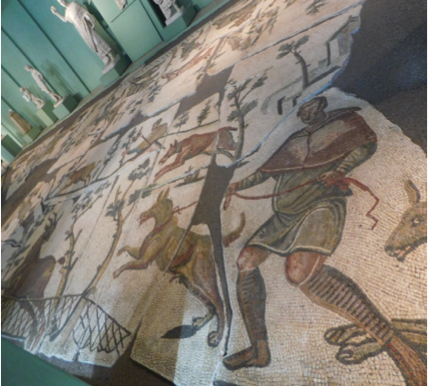 |
| Two scenes from a mosaic which depicts a wild hunt. |
Additionally, the games are perhaps one of the most famous aspects of the Roman world for the modern reader, and their importance can be seen in the way Juvenal suggests all the Roman people wanted was “bread and circuses” (Satires, 10). Alongside the famous gladiators, animal shows, called venationes, were commonly held. During these events, great effort was made to make the colosseum appear like a hunting ground, including the use of scenery, and many animals are recorded as being used, such as big cats, elephants, bears, and herbivores such as boar, deer, and more exotically, zebras. These unfortunate creatures were transported from the conquered provinces, as symbols of Roman superiority over nature, and their empire. Importantly, all these animals can be seen on tokens. Although many tokens are unclear because of the damage they have incurred over the centuries, lions and elephants are instantly recognisable because of their manes and tusks respectively. Elephants were important symbols during the games, and were even depicted coinage. Their size and strength made them signs of the emperor’s might and generosity, thus they became a representation of the games as a whole. Furthermore, lions were commonly used both in the games and images across the Roman world, such as mosaics, where they are seen as vicious, and fearful creatures, who would have been impressive in the amphitheatre. Both these animals therefore hint at the role tokens could have had in the games, again perhaps as a commemorative item.
 |
 |
|
A Roman coin featuring an elephant fighting a big cat in the amphitheatre.
|
A mosaic from Pompeii depicting a lion. |
Perhaps the most illuminating piece of information about the use of tokens in relation to the games comes from literature. Martial tells us “now a large number of tessera allots animals which were watched…now a bird rejoices to fall into a safe lap and is assigned owners by lottery in its absence, to save it from being ripped apart” (Epigrams, 8.78.7-12). This seems to suggest that the meat of the animals would have been distributed to the crowds after the shows, using the tessera, the Latin word for tokens, for ease. Indeed there is no evidence of storage space, or the burial of the dead animals in the colosseum, and while this is disgusting to the modern reader, this practice would have provided a way to both please the populous, and deal with waste. This therefore seems like their most likely use, especially since some tokens do depict birds, as mentioned in the extract.
There are certainly many different examples of animal tokens, and many different possible uses for them, including both practical and commemorative functions. They show how tokens could be closely connected to the world of entertainment, as well as the variety of animals in Roman society.
 |
This month's piece was written by Rebecca Rolfe, a Classical Civilisation with Study in Europe student currently on her year abroad in Italy. She is interested in the importance of iconography in Roman artwork, and the symbolism of images on Roman coins. Over the summer of 2017 Becky conducted research on the animal tokens of Rome with the support of Warwick's Undergraduate Research Support Scheme. As part of her research she translated a segment of Rostovtzeff's Latin catalogue of Roman tokens related to spectacles into English. If you want to learn more about these tokens, the translation is available here!
Bibliography:
Anderson, John Kinloch (1985), Hunting in the Ancient World (Berkley, University of California Press).
Bell, Sinclair and Willekes, Carolyn (2014) ‘Horse Racing and Chariot Racing’, in The Oxford Handbook of Animals in Classical Thought and Life, ed Gordon Lindsay Campbell (Oxford, Oxford University Press) 478-491.
Harrison, George (2001), ‘Martial on Sportula and the Saturnalia’, in Mouseion: Journal of the Classical Association of Canada, Vol 1, No. 3, pages 295-312.
Jennison, George (1937), Animals for Show and Pleasure in Ancient Rome (Manchester, University of Manchester Press).
Kyle, Donald (2007), Sport and Spectacle in the Ancient World (Oxford, Blackwell).
MacKinnon, Michael (2014) ‘Hunting’, in The Oxford Handbook of Animals in Classical Thought and Life, ed Gordon Lindsay Campbell (Oxford,Oxford University Press) 203-216.
Meijer, Fik (2010), Chariot Racing in the Roman Empire (Baltimore, John Hopkins University Press).
Scullard, Howard Hayes (1974), The Elephant in the Greek and Roman World (London, Thames and Hudson).
Shelton, Jo-Ann (2014) ‘Spectacles of Animal Abuse’, in The Oxford Handbook of Animals in Classical Thought and Life, ed Gordon Lindsay Campbell (Oxford, Oxford University Press) 461-478.
Toynbee, Jocelyn (1973), Animals in Roman Life and Art (London, Thames and Hudson).
June 01, 2017
Let's play with the portrait of Augustus! "Tesserae" and Roman Games
 |
|
Bone gaming piece showing and naming Augustus.
(From Rostovtzeff's 1904 publication of the find).
|
A variety of objects are given the Latin label “tesserae” by modern scholars: mosaic pieces, lead monetiform objects, spintriae, and small circular objects made out of bone or ivory, like the piece pictured above. On one side is a carved portrait of Augustus, while the other side gives his name in Greek (Σεβαστός) and the number one in both Latin and Greek numerals (I in Latin, A in Greek; the Greeks represented numerals through letters). Scholars originally thought that these bone objects, found all over the Roman world, served as tickets to the theatre, amphitheater or circus. But then this “tessera” and fourteen others were found in a child’s tomb in Kerch (Russia) in 1903, and our understanding of these objects changed completely.
Fifteen bone “tesserae” were found in the tomb placed in a wooden and bronze box, neatly stacked in twos. Each piece had an image engraved on one side and on the other a word accompanied by a number in both Latin and Greek. The numbers range from 1 to 15. The designs of the pieces are as follows, according to the publication of Rostovtzeff 1905 (the counters are now in the Hermitage):
- Head of Augustus / CΕΒΑCΤΟC (Augustus), I and A.
- Head of Zeus / ΖΕΥC (Zeus), II and B.
- An "athletic head" (probably Hermes) / [ΕΡΜ]ΗC (Hermes? The legend is partly obliterated), III and Γ.
- Entrance to an Egyptian building / ΕΛΕΥΣΕΙΝ(ΙΟΝ) (Eleuseinion), IIII and Δ
- Head of Herakles / ΗΡΑΚΛΗΣ (Herakles), V and E
- The word ΗΡΑΙ(Α) (Heraia) in a wreath / YII and the letter vau
- Bust of a praetextatus (a young man wearing a toga) / ΛΟΥΚΙΟΥ (a referenece to a Lucius), VII and Z.
- Head of Kronos / ΧΡΟΝΟC (Kronos), VIII and H.
- The Greek letter Θ / ΠΑΦΟΥ in a wreath (shown below).
- Young female head with a hairstyle of the Augustan age / ΑΦΡΟΔΙΤ(Η) (Aphrodite), Χ and I
- Head of Pollux wearing an athletic headband / ΔΙΟCΚΟΡΟC (Dioscurus), XI and IA.
- Head of Castor wearing an athletic band / ΚΑCΤΩΡ (Castor), XII and IB.
- Head of Aphrodite / ΑΦΡΟΔΙΤ(Η) (Aphrodite), XIII and ΙΓ.
- Bust of Isis / ΙCIC (Isis). The inscription is damaged, but III and ΙΔ are visible.
- Head of Hera / [ΗΡ]Α (Hera, although the inscription is damaged), [X]V and IE.
 |
|
Gaming piece no. 9, reproduced from
Rostovtzeff 1905.
|
Numerous other pieces similar to this have been found throughout the Roman world (e.g. Pompeii, Asia Minor, Athens, Syria, Crete, Vindonissa north of the Alps), but a complete set like this is rare, if not unique. Comparison with other pieces reveal that the numbers do not correlate with any particular image; so while Zeus is paired with number two here, on another set he may be number ten or fifteen, for example. Other pieces have the portraits and names of other emperors and empresses, though none later than Nero; some specimens represent Julius Caesar and one piece carries a portrait of a Ptolemy. This, in addition to the find spots (particularly in Pompeii, and in the abovementioned tomb) suggests a production date ranging from the second half of the first century BC to first century AD, although they may, of course, have been used later than this.
 |
|
"Token", Early 1st century, Ivory. 2.9 cm
(1 1/8 in.) Gift of Marshall and Ruth
Goldberg. J. Paul Getty Museum, CC-BY.
|
This complete set has led scholars to conclude that these are gaming pieces. Many of the surviving specimens carry Egyptian, or more specifically, Alexandrian designs. Our number four, for example, likely represents a sanctuary in Eleusis, which was a suburb in Alexandria. Other suburbs in the city, for example Nikopolis, are also shown and named. On the right is an image of one of these pieces: an obelisk stands next to an Egyptian-style building; the other side names Nikopolis and provides the Latin and Greek number four: IIII and Δ. Egyptian deities feature alongside the busts of gods, rulers and other well-known personalities (e.g. athletes, poets, philosophers, characters from comedies). The current theory, then, is that this was an Alexandrian game that then became popular across the Empire in the first century AD. We have no idea how the game was actually played, although it might have been a mixture of a local Egyptian game and the Greek game of petteia (πεττεία).
We might pause to think what it meant that one could play a game in Pompeii, for example, or in modern day Russia, that represented and played with the Alexandrian landscape, its suburbs, buildings and gods. Could the experience be similar to a modern monopoly board, where British streets and locations are experienced and named by people all over the world? I think we should also consider that people thus might also ‘play’ with the emperor’s portrait; how then did this affect people’s experience of the emperor and his family? But finally, since these bone and ivory objects are gaming counters, we should probably stop calling them “tesserae”!
This Coin of the Month entry was written by Clare Rowan as part of the Token Communities in the Ancient Mediterranean Project.
Bibliography:
Alföldi-Rosenbaum, E. (1976). Alexandriaca. Studies on Roman Game Counters III. Chiron 6: 205-239.
Alföldi-Rosenbaum, E. (1980). Ruler portraits on Roman game counters from Alexandria (Studies on Roman game counters III). Eikones. Studien zum griechischen und römischen Bildnis. ed. R. A. Stucky and I. Jucker. Bern, Francke Verlag Bern: 29-39.
Rostovtsew, M. (1905). Interprétation des tessères en os avec figures, chiffres et légendes. Revue Archéologique 5: 110-124.
September 10, 2015
The bitcoin of antiquity? Community Currencies in Roman Egypt
The use of alternative or community currencies and payment systems is often commented upon in the modern day, whether it is the Bristol pound, Bitcoin, or Ithaca hours. Alternative currencies are also springing up in Greece in the face of its monetary crisis, and may form a way of allowing the domestic economy to continue in the face of austerity. Such currencies also probably existed in the Roman world, used when there was a shortage of official governmental currency or small change. Egypt, for example, has furnished thousands of lead tokens, often bearing the names of different cities (e.g. Memphis). These objects have similarities with the official currency of Egypt that was struck in Alexandria (carrying regnal years as dates, for example), and appear to have been used as local currency once the imperial mint ceased large-scale production in c. AD 220.
 |
|
Lead token of Egypt showing a male figure being crowned by Victory
and the Nile riding a hippopotamus, holding reeds and a cornucopia.
Dated to 'Year 3' of an uncertain era. (Dattari 6462, 19.5mm)
|
Particular tokens are found only in very small areas, often within a city and its hinterland, similar to the way that the Bristol pound, for example, is used only in Bristol. It appears then that these objects were used like the community currencies of the present day, facilitating local transactions and economies within a small area. Their use as money is further suggested by the recent publication of a shipwreck found off the Carmel Coast in Israel. The wreck dates from the 3rd century AD, and contained a hoard of 162 coins (including 68 denarii) including a significant quantity of provincial bronze coins (74 in total), and billon coins from Alexandria. Three Egyptian 'tesserae' or tokens were also in the hoard. The interpretation of the hoard is that it is the purse of a sailor, merchant or ship owner who carried a variety of currencies to save on exchange fees in different ports. The tokens, similar to that shown above (but with different designs) are interpreted as tokens for habour services. But, given that the find contexts of similar objects throughout Egypt show them alongside or in similar contexts to official currency, they should be seen as local currency, hoarded by the owner of the purse along with his other local coinage.
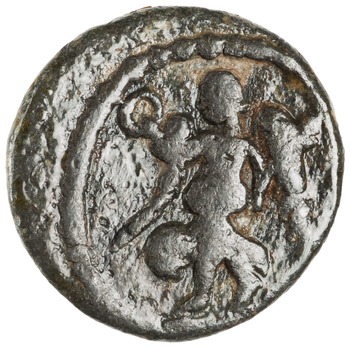 |
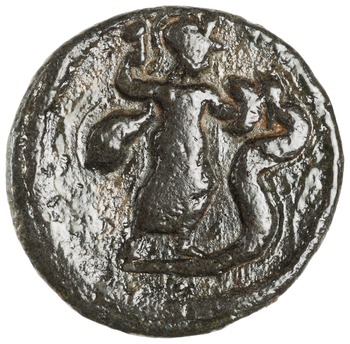 |
These objects shed light on the economic history of Egypt, as well as the self-representation of different groups within the province, similar to the way that the designs of provincial coinage reflect the identities and culture of local cities. That alternative or community currencies existed alongside the denarius system in the Roman Empire reveals how a universal currency used throughout Europe was historically supplemented by other payment systems.
Select Bibliography:
Meshorer, Y. (2010). Coin Hoard from a Third-Century CE Shipwreck off the Carmel Coast, Atiqot 63: 111-135.
Milne, J. G. (1908). The leaden token-coinage of Egypt under the Romans. Numismatic Chronicle 8: 287-310.
Images from Classical Numismatic Group Inc., Electronic Auction 353, lot 369 (www.cngcoins.com), and the American Numismatic Society, 1944.100.79822.
 Clare Rowan
Clare Rowan

 Please wait - comments are loading
Please wait - comments are loading

 Loading…
Loading…

